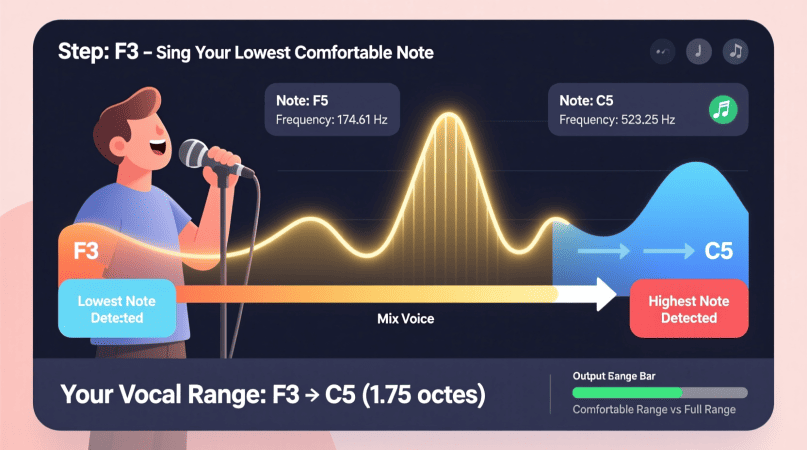
A pitch detector shows you the lowest and highest notes you can sing. That span defines your vocal range. It can also hint at your voice type, highlight where your voice feels comfortable, and track changes over time.
Why Your Vocal Range Matters
- Singers use it to choose songs in the right key.
- Teachers and coaches use it to guide warm-ups and vocal exercises.
- Speakers and performers use it to understand natural pitch and projection.
Knowing your range isn’t about labels—it’s about learning where your voice works best and how to expand it safely.
Try Our: frequency to note converter
What a Pitch Detector Actually Measures
When you sing into a pitch detector, it analyzes the sound and shows:
- Lowest note you can sustain clearly
- Highest note you can reach without strain
- Notes in between, often with frequency (Hz) and musical note name
- Real-time accuracy (whether you are sharp, flat, or steady)
That data gives you a measurable vocal range.
Range vs. Tessitura: More Than Just Extremes
- Range = the lowest to highest notes you can produce.
- Tessitura = where your voice is most comfortable and resonant.
For example, you might technically reach from A2 to A5 (three octaves), but most of your songs will sit in the C3 to G4 zone. That’s your tessitura—the sweet spot.
Voice Types and Typical Ranges
Here’s a simplified guide many singers use:
| Voice Type | Typical Range (approx.) | Notes Example |
|---|---|---|
| Bass | E2 – E4 | Low male voice |
| Baritone | A2 – A4 | Medium male voice |
| Tenor | C3 – C5 | Higher male voice |
| Alto | F3 – F5 | Lower female voice |
| Mezzo-soprano | A3 – A5 | Medium female voice |
| Soprano | C4 – C6 | Higher female voice |
Your pitch detector results can be compared against this chart to see where you fall.
see your vocal pitch in real time
How to Use a Pitch Detector for Range Testing
- Warm up your voice to avoid strain.
- Sing down to your lowest comfortable note and note the result.
- Sing up step by step to your highest clear note.
- Record both extremes and calculate the distance (octaves).
- Compare with standard ranges to get a sense of your voice type.
💡 Tip: Repeat on different days. Your range can shift with rest, training, or fatigue.
What It Can’t Tell You
- It won’t confirm your exact voice classification—that requires a teacher’s guidance.
- It doesn’t judge tone quality, resonance, or style.
- It won’t tell you how long you can hold those notes (endurance).
Think of it as a measuring tape, not a teacher.
Common Questions
Can a pitch detector tell me if I’m a soprano or tenor?
Not directly—it shows your range, but classification depends on tessitura, tone, and training.
Is my range fixed?
No. With consistent practice, most people can safely expand their range by a few notes.
Why does my detector jump between notes?
Background noise, unstable tone, or vibrato can confuse the algorithm.
Can I measure my speaking pitch too?
Yes—most detectors will show the average pitch of your speaking voice.
Takeaway
A pitch detector tells you:
- The span of notes you can sing today (your vocal range).
- Hints about your voice type and tessitura.
- Whether your pitch is steady or drifting sharp/flat.
Use it as a feedback tool, not a final verdict. Combine it with mindful practice and, if possible, guidance from a coach. Over time, you’ll see your results shift as your range grows and your comfort zone expands.
Pitch Detector is a project by Ornella, blending audio engineering and web technology to deliver precise, real-time pitch detection through your browser. Designed for musicians, producers, and learners who want fast, accurate tuning without installing any software.
